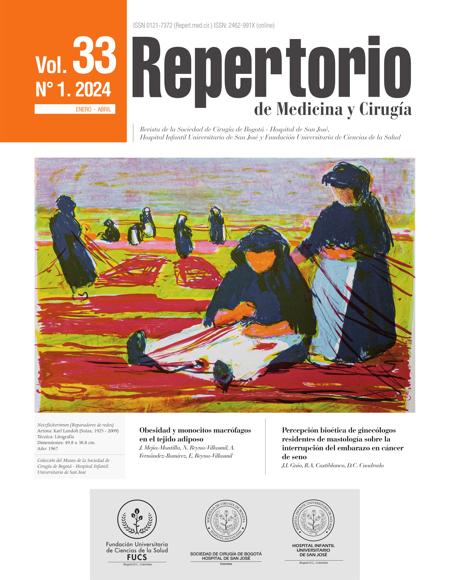Calidad de atención en el manejo de enfermedad cerebrovascular isquémica aguda posterior a la iniciativa angels
Acute ischemic cerebrovascular disease management quality of care following the adoption of the angels initiative
Esta obra está bajo una licencia internacional Creative Commons Atribución-NoComercial-CompartirIgual 4.0.
Mostrar biografía de los autores
Introducción: el ataque cerebrovascular (ACV) es común a nivel mundial, una de cada cuatro personas puede presentarlo a lo largo de la vida. Constituye la segunda causa de muerte y la tercera principal de discapacidad. Es importante la atención integral para lograr un impacto en la calidad de vida. Objetivo: determinar la calidad de atención en el manejo del ACV isquémico agudo de los pacientes que consultaron al servicio de neurología en los Hospitales de San José e Infantil Universitario de San José, Bogotá DC, entre enero 1/2019 y enero 1/2020. Metodología: estudio descriptivo de corte transversal. El criterio de inclusión fue pacientes mayores de 18 años con diagnóstico de ACV isquémico. La información se recolectó de las historias clínicas, se empleó estadística descriptiva para analizar los datos. Resultados: se incluyeron 411 pacientes, 88,8% sin alteración del estado de conciencia, 26,4% ingresaron antes de las 4,5 horas de ventana para trombólisis, se realizaron procedimientos de recanalización endovenosa a 11,4%. El tiempo puerta aguja tuvo una mediana de 37,2 minutos comparado con la mediana nacional de tiempo que fue 56,5 min según lo registrado en la plataforma ResQ. El 72% recibió terapia antiagregante y estatina 88.8%. Discusión y conclusiones: al identificar los síntomas es importante ser estrictos en el tiempo de atención y la implementación de plataformas para óptimos planes de atención. Se requieren campañas masivas de educación, así como que planes de mejora institucionales.
Visitas del artículo 1223 | Visitas PDF 486
Descargas
- Campbell BCV, Khatri P. Stroke. Lancet. 2020;396(10244):129-42. https://doi.org/10.1016/S0140-6736(20)31179-X DOI: https://doi.org/10.1016/S0140-6736(20)31179-X
- Feigin VL, Nguyen G, Cercy K, Johnson CO, Alam T, Parmar PG, et al. Global, Regional, and Country-Specific Lifetime Risks of Stroke, 1990 and 2016. N Engl J Med. 2018;379(25):2429-37. https://doi.org/10.1056/NEJMoa1804492 DOI: https://doi.org/10.1056/NEJMoa1804492
- Herpich F, Rincon F. Management of Acute Ischemic Stroke. Critical Care Medicine. 2020;48(11):1654-1663. https://doi.org/10.1097/CCM.0000000000004597 DOI: https://doi.org/10.1097/CCM.0000000000004597
- Rabinstein A. Update on Treatment of Acute Ischemic Stroke. Continuum (Minneap Minn). 2020;26(2):268-286. https://doi.org/10.1212/CON.0000000000000840 DOI: https://doi.org/10.1212/CON.0000000000000840
- Powers WJ, Rabinstein AA, Ackerson T, Adeoye OM, Bambakidis NC, Becker K, et al. Guidelines for the Early Management of Patients With Acute Ischemic Stroke: 2019 Update to the 2018 Guidelines for the Early Management of Acute Ischemic Stroke: A Guideline for Healthcare Professionals From the American Heart Association/American Stroke Association. Stroke. 2019;50(12):e344-e418. https://doi.org/10.1161/STR.0000000000000211 DOI: https://doi.org/10.1161/STR.0000000000000211
- Mendelson SJ,Prabhakaran S. Diagnosis and Management of Transient Ischemic Attack and Acute Ischemic Stroke: A Review. JAMA 2021 Mar 16;325(11):1088-1098. https://doi.org/10.1001/jama.2020.26867 DOI: https://doi.org/10.1001/jama.2020.26867
- Montaño A, Hanley DF, Hemphill C. Hemorrhagic stroke. Handbook of Clinical Neurology. 2021;176:229-248. https://doi.org/10.1016/B978-0-444-64034-5.00019-5 DOI: https://doi.org/10.1016/B978-0-444-64034-5.00019-5
- Pandian JD, Gall SL, Kate MP, Silva GS, Akinyemi RO, Ovbiagele BI, et al. Prevention of stroke: a global perspective. Lancet. 2018;392(10154):1269-78. https://doi.org/10.1016/S0140-6736(18)31269-8 DOI: https://doi.org/10.1016/S0140-6736(18)31269-8
- Feske S. Ischemic Stroke. The American Journal of Medicine. 2021 Dec;134(12):1457-1464. https://doi.org/10.1016/j.amjmed.2021.07.027 DOI: https://doi.org/10.1016/j.amjmed.2021.07.027
- Powers WJ. Acute Ischemic Stroke. N Engl J Med. 2020;383(3):252-60. https://doi.org/10.1056/NEJMcp1917030 DOI: https://doi.org/10.1056/NEJMcp1917030
- Rabinstein AA. Update on Treatment of Acute Ischemic Stroke. Continuum (Minneap Minn). 2020;26(2):268-86. https://doi.org/10.1212/CON.0000000000000840 DOI: https://doi.org/10.1212/CON.0000000000000840
- Jolugbo P, Ariëns AS. Thrombus Composition and Efficacy of Thrombolysis and Thrombectomy in Acute Ischemic Stroke. Stroke. 2021;52(3):1131-1142. https://doi.org/10.1161/STROKEAHA.120.032810 DOI: https://doi.org/10.1161/STROKEAHA.120.032810
- Kuriakose D, Xiao Z. Pathophysiology and Treatment of Stroke: Present Status and Future Perspectives. Int J Mol Sci. 2020;21(20). https://doi.org/10.3390/ijms21207609 DOI: https://doi.org/10.3390/ijms21207609
- Katan M, Luft A. Global Burden of Stroke. Semin Neurol. 2018;38(2):208-11. https://doi.org/10.1055/s-0038-1649503 DOI: https://doi.org/10.1055/s-0038-1649503
- Gurol ME. Secondary Stroke Prevention in Atrial Fibrillation: New Insights Into an Old Problem. Stroke. 2018;49(6):1315-7. https://doi.org/10.1161/STROKEAHA.118.021262 DOI: https://doi.org/10.1161/STROKEAHA.118.021262
- Campbell BCV, De Silva DA, Macleod MR, Coutts SB, Schwamm LH, Davis SM, et al. Ischaemic stroke. Nat Rev Dis Primers. 2019;5(1):70. https://doi.org/10.1038/s41572-019-01188 DOI: https://doi.org/10.1038/s41572-019-0118-8
- Guo Y, Lane DA, Wang L, Zhang H, Wang H, Zhang W, et al. Mobile Health Technology to Improve Care for Patients With Atrial Fibrillation. J Am Coll Cardiol. 2020;75(13):1523-34. https://doi.org/10.1016/j.jacc.2020.01.052 DOI: https://doi.org/10.1016/j.jacc.2020.01.052
- Moreno E, Rodríguez J, Bayona-Ortiz H. Trombólisis endovenosa como tratamiento del ACV isquémico agudo en Colombia: una revisión sistemática de la literatura. Acta Neurol Colomb. 2019;35(3):156-66. https://doi.org/10.22379/24224022262 DOI: https://doi.org/10.22379/24224022262
- Schwarzbach C J, Eichner F A, Pankert A, et al,. Stroke aftercare : Treatment reality, challenges and future perspectives. Nervenarzt. 2020;91(6):477-483. https://doi.org/10.1007/s00115-020-00909-w DOI: https://doi.org/10.1007/s00115-020-00909-w
- Phipps MS, Cronin CA. Management of acute ischemic stroke. BMJ. 2020;368:l6983. https://doi.org/10.1136/bmj.l6983 DOI: https://doi.org/10.1136/bmj.l6983
- Saini V, Guada L, Yavagal DR. Global Epidemiology of Stroke and Access to Acute Ischemic Stroke Interventions. Neurology. 2021;97(20 Suppl 2):S6-S16. https://doi.org/10.1212/WNL.0000000000012781 DOI: https://doi.org/10.1212/WNL.0000000000012781
- McMeekin P, White P, James MA, Price CI, Flynn D, Ford GA. Estimating the number of UK stroke patients eligible for endovascular thrombectomy. Eur Stroke J. 2017;2(4):319-26. https://doi.org/10.1177/2396987317733343 DOI: https://doi.org/10.1177/2396987317733343
- Marganska V. Stroke Rehabilitation: Therapy Robots and Assistive Devices. Adv Exp Med Biol. 2018;1065:579-587. https://doi.org/10.1007/978-3-319-77932-4_35 DOI: https://doi.org/10.1007/978-3-319-77932-4_35
- Joundi R, Menon B. Thrombus Composition, Imaging, and Outcome Prediction in Acute Ischemic Stroke.Neurology. 2021 Nov 16;97(20 Suppl 2):S68-S78. https://doi.org/10.1212/WNL.0000000000012796 DOI: https://doi.org/10.1212/WNL.0000000000012796
- Kirchhof P, Camm AJ, Goette A, Brandes A, Eckardt L, Elvan A, et al. Early Rhythm-Control Therapy in Patients with Atrial Fibrillation. N Engl J Med. 2020;383(14):1305-16. https://doi.org/10.1056/NEJMoa2019422 DOI: https://doi.org/10.1056/NEJMoa2019422
- Dharmakidari S, Bhattacharya P, Chaturvedi S. Carotid Artery Stenosis: Medical Therapy, Surgery, and Stenting. Curr Neurol Neurosci Rep. 2017;17(10):77. https://doi.org/10.1007/s11910-017-0786-2 DOI: https://doi.org/10.1007/s11910-017-0786-2
- Ibeh C, Elkind SV. Stroke Prevention After Cryptogenic Stroke. Current Cardiology Reports. 2021;23(12):174. https://doi.org/10.1007/s11886-021-01604-1 DOI: https://doi.org/10.1007/s11886-021-01604-1
- Flach C, Muruet W, Wolfe C, et al,. Risk and Secondary Prevention of Stroke Recurrence: A Population-Base Cohort Study. Stroke. 2020;51(8):2435-2444. https://doi.org/10.1161/STROKEAHA.120.028992 DOI: https://doi.org/10.1161/STROKEAHA.120.028992
- Aznaouridis K, Masoura C, Vlachopoulos C, Tousoulis D. Statins in Stroke. Curr Med Chem. 2019;26(33):6174-85. https://doi.org/10.2174/0929867326666190620104539 DOI: https://doi.org/10.2174/0929867326666190620104539
- Caprio FZ, Sorond FA. Cerebrovascular Disease: Primary and Secondary Stroke Prevention. Med Clin North Am. 2019;103(2):295-308. https://doi.org/10.1016/j.mcna.2018.10.001 DOI: https://doi.org/10.1016/j.mcna.2018.10.001













